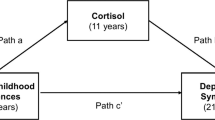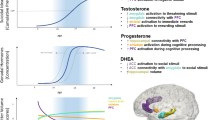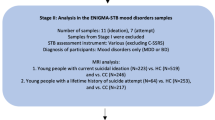Abstract
Studies looking at the relationship of the hypothalamic–pituitary–adrenal (HPA) axis to suicidal behavior and its risk factors, such as depression, childhood abuse, and impulsive aggression, report inconsistent results. These studies also do not always differentiate between subjects who go on to attempt suicide, suicidal subjects who never attempted suicide, and non-suicidal subjects with psychiatric disorders. In this study, we examined cortisol responses to an experimental stressor, the Trier Social Stress Test (TSST), in 208 offspring of parents with mood disorder. Offspring suicide attempters showed lower total cortisol output (β=−0.47, 95% CI (−0.83, −0.11), p=0.01) compared with offspring with suicide-related behavior (SRB) but never attempted, non-suicidal offspring, and a healthy control group. The result remained significant even after controlling for sex, age, race, ethnicity, site, socio-economic status, and hour of the day when the TSST was conducted. Suicide attempters also showed lower baseline cortisol before the TSST (β=−0.45, 95% CI (−0.74, −0.17), p=0.002). However, there were no significant differences between the groups on cortisol reactivity to stress (β=4.5, 95% CI (−12.9, 22), p=0.61). Although subjects with suicide attempt and SRB have similar clinical and psychosocial characteristics, this is the first study to differentiate them biologically on HPA axis indices. Blunted HPA axis activity may increase risk for suicide attempt among individuals with psychopathology by reducing their ability to respond adaptively to ongoing stressors. These results may help better identify subjects at high risk for suicidal behavior for targeted prevention and intervention efforts.
Similar content being viewed by others
Log in or create a free account to read this content
Gain free access to this article, as well as selected content from this journal and more on nature.com
or
References
Angst J, Angst F, Gerber-Werder R, Gamma A (2005). Suicide in 406 mood-disorder patients with and without long-term medication: a 40 to 44 years' follow-up. Arch Suicide Res 9: 279–300.
Arsenault-Lapierre G, Kim C, Turecki G (2004). Psychiatric diagnoses in 3275 suicides: a meta-analysis. BMC Psychiatry 4: 37.
Beck AT, Ward CH, Mendelson M, Mock J, Erbaugh J (1961). An inventory for measuring depression. Arch Gen Psychiatry 4: 561–571.
Bernstein DP, Fink L, Handelsman L, Foote J, Lovejoy M, Wenzel K et al (1994). Initial reliability and validity of a new retrospective measure of child abuse and neglect. Am J Psychiatry 151: 1132–1136.
Brent DA, Emslie GJ, Clarke GN, Asarnow J, Spirito A, Ritz L et al (2009). Predictors of spontaneous and systematically assessed suicidal adverse events in the treatment of SSRI-resistant depression in adolescents (TORDIA) study. Am J Psychiatry 166: 418–426.
Brent DA, Melhem NM, Oquendo M, Burke A, Birmaher B, Stanley B et al (2015). Familial pathways to early-onset suicide attempt: a 5.6-year prospective study. JAMA Psychiatry 72: 160–168.
Buss AH, Durkee A (1957). An inventory for assessing different kinds of hostility. J Consult Psychol 21: 343–349.
Cohen J (1988) Statistical Power Analysis for the Behavioral Sciences, 2nd edn. Lawrence Erlbaum Associates: New Jersey.
Coryell W, Young E, Carroll B (2006). Hyperactivity of the hypothalamic-pituitary-adrenal axis and mortality in major depressive disorder. Psychiatry Res 142: 99–104.
Crosby A, Ortega L, Melanson C (2011) Self-Directed Violence Surveillance: Uniform Definitions and Recommended Data Elements. Centers for Disease Control and Prevention: Atlanta.
Danese A, McEwen BS (2012). Adverse childhood experiences, allostasis, allostatic load, and age-related disease. Physiol Behav 106: 29–39.
Dietz LJ, Stoyak S, Melhem N, Porta G, Matthews KA, Walker Payne M et al (2013). Cortisol response to social stress in parentally bereaved youth. Biol Psychiatry 73: 379–387.
Ellenbogen MA, Hodgins S, Linnen AM, Ostiguy CS (2011). Elevated daytime cortisol levels: a biomarker of subsequent major affective disorder? J Affect Disord 132: 265–269.
Ellenbogen MA, Hodgins S, Walker CD, Couture S, Adam S (2006). Daytime cortisol and stress reactivity in the offspring of parents with bipolar disorder. Psychoneuroendocrinology 31: 1164–1180.
Endicott J, Spitzer RL, Fleiss JL, Cohen J (1976). The global assessment scale. a procedure for measuring overall severity of psychiatric disturbance. Arch Gen Psychiatry 33: 766–771.
Fountoulakis KN, Iacovides A, Fotiou F, Nimatoudis J, Bascialla F, Ioannidou C et al (2004). Neurobiological and psychological correlates of suicidal attempts and thoughts of death in patients with major depression. Neuropsychobiology 49: 42–52.
Golden SH, Wand GS, Malhotra S, Kamel I, Horton K (2011). Reliability of hypothalamic-pituitary-adrenal axis assessment methods for use in population-based studies. Eur J Epidemiol 26: 511–525.
Harkness KL, Stewart JG, Wynne-Edwards KE (2011). Cortisol reactivity to social stress in adolescents: role of depression severity and child maltreatment. Psychoneuroendocrinology 36: 173–181.
Jokinen J, Nordstrom P (2009). HPA axis hyperactivity and attempted suicide in young adult mood disorder inpatients. J Affect Disord 116: 117–120.
Jokinen J, Ouda J, Nordstrom P (2010). Noradrenergic function and HPA axis dysregulation in suicidal behaviour. Psychoneuroendocrinology 35: 1536–1542.
Kalsbeek A, van der Spek R, Lei J, Endert E, Buijs RM, Fliers E (2012). Circadian rhythms in the hypothalamo-pituitary-adrenal (HPA) axis. Mol Cell Endocrinol 349: 20–29.
Kamali M, Saunders EF, Prossin AR, Brucksch CB, Harrington GJ, Langenecker SA et al (2012). Associations between suicide attempts and elevated bedtime salivary cortisol levels in bipolar disorder. J Affect Disord 136: 350–358.
Kaufman J, Birmaher B, Brent D, Rao U, Flynn C, Moreci P et al (1997). Schedule for Affective Disorders and Schizophrenia for School-Age Children-Present and Lifetime Version (K-SADS-PL): initial reliability and validity data. J Am Acad Child Adolesc Psychiatry 36: 980–988.
Kirschbaum C, Kudielka BM, Gaab J, Schommer NC, Hellhammer DH (1999). Impact of gender, menstrual cycle phase, and oral contraceptives on the activity of the hypothalamus-pituitary-adrenal axis. Psychosom Med 61: 154–162.
Kirschbaum C, Pirke KM, Hellhammer DH (1993). The 'Trier Social Stress Test—a tool for investigating psychobiological stress responses in a laboratory setting. Neuropsychobiology 28: 76–81.
Kudielka BM, Schommer NC, Hellhammer DH, Kirschbaum C (2004). Acute HPA axis responses, heart rate, and mood changes to psychosocial stress (TSST) in humans at different times of day. Psychoneuroendocrinology 29: 983–992.
Mann JJ (2003). Neurobiology of suicidal behaviour. Nat Rev Neurosci 4: 819–828.
Mann JJ, McBride PA, Brown RP, Linnoila M, Leon AC, DeMeo M et al (1992). Relationship between central and peripheral serotonin indexes in depressed and suicidal psychiatric inpatients. Arch Gen Psychiatry 49: 442–446.
Mannie ZN, Harmer CJ, Cowen PJ (2007). Increased waking salivary cortisol levels in young people at familial risk of depression. Am J Psychiatry 164: 617–621.
McGirr A, Diaconu G, Berlim MT, Pruessner JC, Sable R, Cabot S et al (2010). Dysregulation of the sympathetic nervous system, hypothalamic-pituitary-adrenal axis and executive function in individuals at risk for suicide. J Psychiatry Neurosci 35: 399–408.
McGirr A, Diaconu G, Berlim MT, Turecki G (2011). Personal and family history of suicidal behaviour is associated with lower peripheral cortisol in depressed outpatients. J Affect Disord 131: 368–373.
McGowan PO, Sasaki A, D'Alessio AC, Dymov S, Labonte B, Szyf M et al (2009). Epigenetic regulation of the glucocorticoid receptor in human brain associates with childhood abuse. Nat Neurosci 12: 342–348.
McNair DM, Lorr M, Droppleman LF (1992). EdITS manual for the Profile of Mood States. EdITS Educational & Industrial Testing Service: San Diego: CA, 1992.
Melhem NM, Brent DA, Ziegler M, Iyengar S, Kolko D, Oquendo M et al (2007). Familial pathways to early-onset suicidal behavior: familial and individual antecedents of suicidal behavior. Am J Psychiatry 164: 1364–1370.
Mesman E, Nolen WA, Reichart CG, Wals M, Hillegers MH (2013). The Dutch bipolar offspring study: 12-year follow-up. Am J Psychiatry 170: 542–549.
Meyer RE, Salzman C, Youngstrom EA, Clayton PJ, Goodwin FK, Mann JJ et al (2010). Suicidality and risk of suicidedefinition, drug safety concerns, and a necessary target for drug development: a consensus statement. J Clin Psychiatry 71: e1–e21.
Owens M, Herbert J, Jones PB, Sahakian BJ, Wilkinson PO, Dunn VJ et al (2014). Elevated morning cortisol is a stratified population-level biomarker for major depression in boys only with high depressive symptoms. Proc Natl Acad Sci 111: 3638–3643.
Pariante CM, Thomas SA, Lovestone S, Makoff A, Kerwin RW (2004). Do antidepressants regulate how cortisol affects the brain? Psychoneuroendocrinology 29: 423–447.
Pfennig A, Kunzel HE, Kern N, Ising M, Majer M, Fuchs B et al (2005). Hypothalamus-pituitary-adrenal system regulation and suicidal behavior in depression. Biol Psychiatry 57: 336–342.
Pitchot W, Scantamburlo G, Pinto E, Hansenne M, Reggers J, Ansseau M et al (2008). Vasopressin-neurophysin and DST in major depression: relationship with suicidal behavior. J Psychiatr Res 42: 684–688.
Poustka L, Maras A, Hohm E, Fellinger J, Holtmann M, Banaschewski T et al (2010). Negative association between plasma cortisol levels and aggression in a high-risk community sample of adolescents. J Neural Transm 117: 621–627.
Pruessner JC, Kirschbaum C, Meinlschmid G, Hellhammer DH (2003). Two formulas for computation of the area under the curve represent measures of total hormone concentration versus time-dependent change. Psychoneuroendocrinology 28: 916–931.
Spitzer RL, Williams JB, Gibbon M, First MB (1992). The Structured Clinical Interview for DSM-III-R (SCID). I: History, rationale, and description. Arch Gen Psychiatry 49: 624–629.
StataCorp (2009) Stata Statistical Software: Release 11. StataCorp LP: College Station, TX, USA.
Teicher MH, Samson JA (2013). Childhood maltreatment and psychopathology: a case for ecophenotypic variants as clinically and neurobiologically distinct subtypes. Am J Psychiatry 170: 1114–1133.
US Department of Health and Human Services (2012) Guidance for Industry. Suicidal Ideation and Behavior: Prospective Assessment of Occurrence in Clinical Trials, Silver Spring, MD.
Waugh CE, Muhtadie L, Thompson RJ, Joormann J, Gotlib IH (2012). Affective and physiological responses to stress in girls at elevated risk for depression. Dev Psychopathol 24: 661–675.
Wolfram M, Bellingrath S, Feuerhahn N, Kudielka BM (2013). Cortisol responses to naturalistic and laboratory stress in student teachers: comparison with a non-stress control day. Stress Health 29: 143–149.
Yehuda R, Flory JD, Pratchett LC, Buxbaum J, Ising M, Holsboer F (2010). Putative biological mechanisms for the association between early life adversity and the subsequent development of PTSD. Psychopharmacology (Berl) 212: 405–417.
Yerevanian BI, Feusner JD, Koek RJ, Mintz J (2004). The dexamethasone suppression test as a predictor of suicidal behavior in unipolar depression. J Affect Disord 83: 103–108.
Author information
Authors and Affiliations
Corresponding author
Additional information
Supplementary Information accompanies the paper on the Neuropsychopharmacology website
Supplementary information
PowerPoint slides
Rights and permissions
About this article
Cite this article
Melhem, N., Keilp, J., Porta, G. et al. Blunted HPA Axis Activity in Suicide Attempters Compared to those at High Risk for Suicidal Behavior. Neuropsychopharmacol 41, 1447–1456 (2016). https://doi.org/10.1038/npp.2015.309
Received:
Revised:
Accepted:
Published:
Issue date:
DOI: https://doi.org/10.1038/npp.2015.309
This article is cited by
-
The mediating role of early maladaptive schemas in the relationship between early childhood trauma and alexithymia
Current Psychology (2023)
-
How Does COVID-19 Affect the Neurobiology of Suicide?
Current Psychiatry Reports (2021)
-
Environmental Stressors May Drive Inflammation and Alter Neurocircuitry to Promote Suicidal Behavior
Current Psychiatry Reports (2019)
-
HPA axis response and psychosocial stress as interactive predictors of suicidal ideation and behavior in adolescent females: a multilevel diathesis-stress framework
Neuropsychopharmacology (2018)
-
Suicide Risk and the Menstrual Cycle: a Review of Candidate RDoC Mechanisms
Current Psychiatry Reports (2018)



